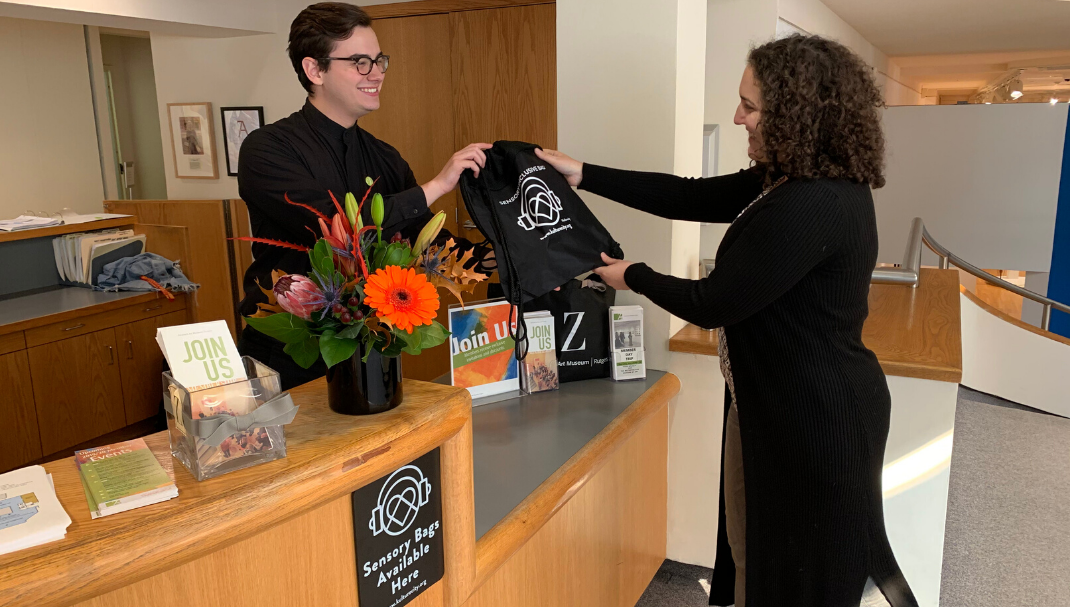Eli Kaberon, March 13, 2020
There are more than 60,000 works in the collection at the Zimmerli Art Museum on the campus of Rutgers University, including paintings and sculptures from all over the world.
The museum regularly hosts community events and traveling exhibitions. It is among the most popular spots on the Rutgers campus for locals and visitors alike.
And now, thanks to a recent initiative, the museum will be accessible to a whole new audience. In December, the museum became the first of its kind in New Jersey to provide specialized assistance for guests on the autism spectrum.
For these individuals, museum can be a sensory overload. To counter this, the Zimmerli offers fidget tools for easing the sense of touch, noise-cancelling headphones for when the environment becomes too loud, weighted lap pads that provide grounding and cue cards for guests that have trouble communicating with their words.
 The museum?s administrators, board of overseers and even the on-floor staff partnered with a nonprofit organization called KultureCity to make these changes and learn more about the issues that impact many of their guests.
The museum?s administrators, board of overseers and even the on-floor staff partnered with a nonprofit organization called KultureCity to make these changes and learn more about the issues that impact many of their guests.
?Through this process, we have learned there is no one set of triggers for sensory issues,? said Amanda Potter, the museum?s Curator of Education and Interpretation. ?What we appreciate very much is that it prepared us for all situations. [This] helps us be more welcoming and inclusive to a wide number of communities, children and adults with autism, but far beyond that as well. It helps us recognize when there is an issue, treating that person with calmness and guiding them to the resources they need, communicating more clearly. Those are things that affect almost every visitor.?
These changes were initiated by Todd Cassie, a Ph.D. candidate in Art History and Cultural Heritage and Preservation Studies at Rutgers and a member of the Board of Overseers at the Zimmerli Art Museum.
Cassie wanted the museum to be more accessible to marginalized groups. A friend of his has a daughter on the autism spectrum, so he suggested that a good place to start would be making the space more sensory-inclusive.
Extensive research led Zimmerli's staff to pursue a partnership with KultureCity. Cassie led the fundraising charge to ensure the museum could go all-in on adopting the suggestions that KultureCity brought to them.
The buy-in was greater than the decision-makers even expected. Potter said there wasn?t a moment of hesitation when the museum talked about taking this on.

KultureCity requests that at least 55 percent of a building?s staff take training; at the Zimmerli, 100 percent of the front-line museum employees were trained. Thomas Sokolowski, the museum?s director, said that not only did the full-time staff partake in the training, but also every student volunteer was agreed to learn how to improve the experience of guests with sensory challenges. And, as new guards or employees join the museum, the training is now part of their onboarding procedure.
?It?s wonderful that the museum has people like Tom and Amanda, people who are open to new ideas on the cutting edge,? Cassie said. ?Some places can be conservative and just do things the way they?ve always done it.?
?It?s so fulfilling, because when you see somebody is having a problem, you at least have an idea on how to fix it,? added Sokolowski. ?That can really help somebody who needs assistance to enjoy the museum to enrich their lives. More open and relaxing than the strict rules that many museums may have.?







 See what's coming up live on B1G+ every day of the season at BigTenPlus.com.
See what's coming up live on B1G+ every day of the season at BigTenPlus.com. 